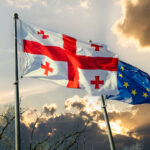In almost 60 per cent of banks in Emerging Market and Developing Economies (EMDEs)—a grouping which includes many of the countries of emerging Europe and Central Asia—lending for climate-related investment accounts for less than five per cent of their overall portfolios, and more than one-quarter offer no climate financing at all, according to a new World Bank report.
This is significant because in developing economies, banks dominate the financial sector, unlike in advanced economies where the financial sector is more diversified.
Climate change is expected to have a significant impact on economic opportunities and development outcomes in EMDEs, requiring far greater investment than they currently receive. Banks in EMDEs have the potential to play a larger role in closing the climate financing gap.
“Emerging market and developing economies face substantial financing gaps in low-carbon, climate-resilient investments. We need to step up climate action and crowd in private investment for countries most in need,” says Axel van Trotsenburg, World Bank senior managing director of development policy and partnerships.
“This requires collective action, and the banking sector is indispensable in this transition process. It can play a pivotal role in financing a green, low-carbon, and sustainable development path.”
Globally, banking authorities are testing new approaches to support climate financing, without compromising on the important goals of financial sector stability and inclusion for underserved people.
For example, the adoption of green and sustainable taxonomies—a classification system that identifies activities and investments to move countries toward specific environmental and other targets—is essential to increasing climate-related lending. Today they cover only 10 per cent of EMDEs compared with 76 per cent of advanced economies.
“Adaptation is underfunded—only 16 per cent of domestic and international climate finance in emerging market and developing economies is channeled for adaptation. Out of this small share, 98 per cent is either public resources or official financing,” adds Pablo Saavedra, World Bank vice president for prosperity.
“In addition to increased climate-lending from banks, reducing this gap requires larger capital and insurance markets in developing economies to provide essential long-term funding for critical climate resilient infrastructure. It’s also important to improve financial access for people, particularly those in vulnerable groups.”
The report, Finance and Prosperity 2024, is the inaugural edition of an annual series that examines financial sector developments and vulnerabilities in low- and middle-income countries.
Based on new data, the report highlights a divergence in the resilience and stability of financial sectors. An analysis of 50 countries, which represent 93 per cent of total bank assets in EMDEs, found that 30 per cent of these countries face high financial-sector risks in the next 12 months.
The majority do not have an adequate policy framework and the institutional capacity to deal with financial stability challenges.
Risks for CEE & Central Asia
While the report notes that financial sector risks are particularly high in South Asia, Sub-Saharan Africa, and some jurisdictions in the Middle East and North Africa, where a combination of high debt levels and external imbalances creates acute macroeconomic vulnerabilities that may harm the financial sector with potential adverse spillovers to the real economy, and that the situation in Europe and Central Asia is “more benign”, there are still risks.
In Europe and Central Asia, high dollarisation, a heavy reliance on remittances, and fast growth in consumer lending render the financial systems of South Caucasus and Central Asian countries vulnerable to foreign currency and credit risks.
Moreover, countries whose banking sectors have more direct links with the Russian Federation banks (such as Armenia, Kazakhstan, Kyrgyzstan, Tajikistan, and Uzbekistan) face “de-risking” challenges because of correspondent banking relationships and sanctions compliance.
In the Russian Federation and Ukraine, there is significant uncertainty about the true health of those countries’ financial systems.
Market discipline
The report also calls attention to the excessive holdings of government debt by domestic banks—an Achilles heel for some economies—particularly those with weaker macroeconomic policies, facing public debt sustainability challenges. Between 2012 and 2023, the exposure of banks to government debt surged by over 35 per cent.
The report recommends countries to strengthen bank buffers well in advance, operationalise financial safety nets, conduct stress tests, and put in place a variety of essential tools.
These include strong interagency crisis-management mechanisms, fully operational emergency liquidity assistance, robust bank resolution frameworks, and adequately funded deposit insurance systems to reduce the likelihood of financial stress and spillovers to the overall economy.
Additionally, developing economies should consider introducing disclosure requirements for banks’ exposures to the government to encourage more prudent risk taking by banks and foster market discipline.
Policy falling short
The World Bank’s report broadly comes a week after the publication of a separate study, Energising the Energy Sector in Central-Eastern Europe, coordinated by the Warsaw Enterprise Institute, which highlights that competitive electricity markets decarbonise 66 per cent faster than non-competitive ones.
The report suggests that the CEE region has yet to fully harness the potential of the renewable energy market, given that current energy policies fall short of leveraging in full private sector actors—investors, businesses, and consumers—to effectively tackle the problem of climate change.
Researchers identified 40 different barriers that hinder competition, increase business costs, and deter private investment, thereby slowing decarbonisation in CEE countries.
The report highlights the potential for market-oriented policies to attract more private capital, leading to lower energy prices and alleviating energy poverty, a significant issue in the region.
“By decreasing state control and allowing more private investment, markets can become more competitive, transparent, and efficient,” the report concludes. “This can lead to improved infrastructure, innovation, and, ultimately, a more resilient energy sector.”







